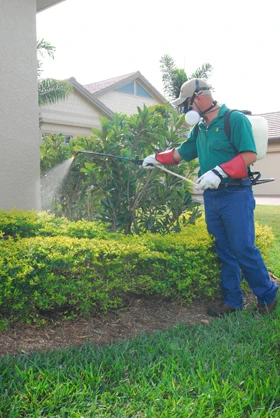
 Looking for cost-effective ways for maintaining landscapes, Smith Grounds Management switched to a plant growth regulator application. In doing so, the Indian Trail, N.C.-based company has significantly cut technicians time on properties and increased overall productivity.
Looking for cost-effective ways for maintaining landscapes, Smith Grounds Management switched to a plant growth regulator application. In doing so, the Indian Trail, N.C.-based company has significantly cut technicians time on properties and increased overall productivity.
"We've had results as much as one pruning a year when we normally do three," says Ray Sammis, Smith Grounds chemical department manager. Sammis introduced Smith Grounds to the labor-saving PGR product eight years ago.
Using PGRs primarily on ornamentals, Smith Grounds has found that the more than $200-per-gallon product it uses has actually saved them money when it can eliminate pruning. Crews might spend 100 hours pruning, and at $30 an hour, Smith Grounds spends $3,000 each year. With the correct application of a PGR, however, companies can save at least half of that, or break even. And, with an additional 100 hours of manpower, crews can be sent out to other billable projects instead of returning to a site again and again, thereby increasing productivity and potentially making a profit.
"PGRs allow us to use manpower more effectively and keep labor costs down, which is what this industry struggles with the most," Sammis says.
Smith Grounds has found particular success in controlling the growth of hollies and other shrubs. For Elaeagnus, a plant that requires constant upkeep, PGRs reduced growth to one pruning and one touch up a year.
"The only downside is that timing is critical," Sammis says. "It's all about getting it applied promptly after the pruning to really get long-term results out of it. If you can control your timing and get it done, it's a great product."
The author is an intern at Lawn & Landscape.
Why and When to use PGRs
Plant growth regulators aren't meant for every application or even every property. But they can help LCOs find time and money savings. We asked Roger Storey, vice president, Turf & Ornamental, SePRO Corp., and David Loecke, professional turf & ornamental products manager at PBI/Gordon, when PGRs should be considered, why they should be included in a company's treatment plan and what new products are available.
Why should LCOs consider using PGRs?
 Storey: Labor costs are probably the most significant costs that landscape companies need to manage. PGRs can be used effectively to reduce the frequency of string trimming and trimming of landscape shrubs and hedges. Landscapers can then reduce the number of employees sent to a property and reallocate that labor to other jobs, resulting in an increase in their profitability.
Storey: Labor costs are probably the most significant costs that landscape companies need to manage. PGRs can be used effectively to reduce the frequency of string trimming and trimming of landscape shrubs and hedges. Landscapers can then reduce the number of employees sent to a property and reallocate that labor to other jobs, resulting in an increase in their profitability.
Loecke: When using PGRs for mowing management, they can offer several benefits including: slower vertical growth of turf allowing for fewer and faster mowing; less trimming and edging; provides an opportunity to reallocate labor for other tasks; reduces clippings, especially after extended periods of rainfall; safety in hard to mow areas such as slopes, obstacles and difficult to access areas.
How are PGRs handled differently than traditional chemicals an LCO would use?
Storey: Probably the biggest difference between PGRs and traditional chemicals that a landscape company might use is application. Since PGR applications are more broadcast applications versus spot treatment, calibration of both the application equipment and the applicator is important. Also, property selection to ensure the best return on investment is also very important. The best properties to select are ones that have higher labor requirements and large treatment areas that will allow the highest reallocation of personnel.
Loecke: LCOs need to be aware of the best time to apply PGRs. Rates and timing must be managed to achieve optimum results.
What should LCOs know about how PGRs work to use the products more effectively?
Storey: There are different modes of action and types of plant uptake that makes selection of the PGR for a specific job important. Modes of action for most PGRs used on turf and landscape are either PGRs that inhibit cell division or inhibit cell elongation. Some PGRs have only foliar uptake and some are primarily taken up by the plant through their roots. PGRs that inhibit cell elongation and are able to be taken up from the roots usually provide longer growth control.
Loecke: PGRs are organic compounds (natural or synthetic), when applied or present in small amounts, (it) results in a change in plant growth and/or development or both. The change may result in better color, increased density, fewer clippings, seedhead suppression, enhanced establishment, improved recuperative potential, deeper roots.
Any new technology in your pipeline?
Storey: SePRO has just introduced a new PGR specifically for the landscape market. It is a product trade named Edgeless Turf Growth Regulator. Edgeless is a patented combination of both foliar and root uptake PGRs that will provide up to eight weeks of growth control on a wide variety of turfgrass.
Loecke: Olive suppression on olive trees with Atrimec is a new use on an existing label.

Explore the January 2012 Issue
Check out more from this issue and find your next story to read.





